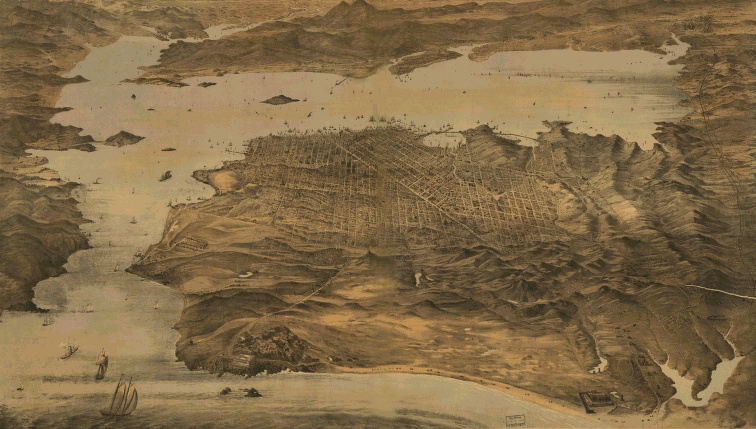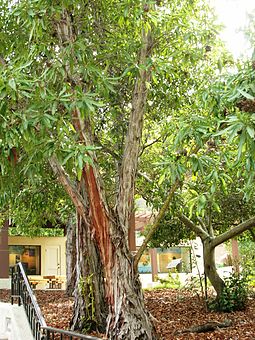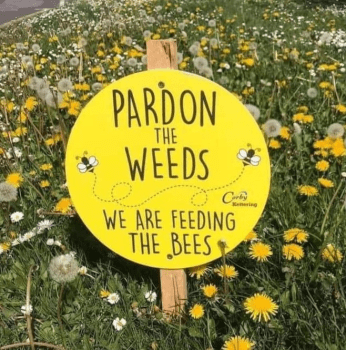In a recent article in Bay Nature, the author tells the story of two California native trees and proposes to answer the question, “Now the question is, where do [these trees] belong?” It’s a thorny question and one that illustrates one of the contradictions of the native plant movement.
The definition of “native” in California is based on the arrival of Europeans near the end of the 18th century, specifically 1769 in the San Francisco Bay Area. Wherever plants or animals lived in 1769, they are considered native in the Bay Area. If they were introduced or arrived after 1769, they are considered non-native, and in many cases designated as “invasive.” Status as “invasive” makes them targets for eradication.
Monterey pine is a case in point. It has a small native range around Monterey, California, just 115 miles south of the East Bay. It was widely planted in the Bay Area by early settlers because the climate is similar to Monterey and much of the Bay Area was treeless. It is well adapted to conditions and thrives here. Yet, it is being eradicated by most public land managers in the Bay Area because it is, strictly speaking, non-native according to the official classification of non-natives.

There is fossil evidence that Monterey pine has lived along the coast of California many times in the past, far outside its small present “native” range. The evidence of its prehistoric past in the Bay Area has not saved it. It wasn’t here in 1769, so it’s gotta go to suit the purist agenda of our public land managers.
But, wait! Maybe our public land managers don’t have such a purist agenda. The same public land managers who are eradicating Monterey pine in the Bay Area are also planting Torrey pines and Catalina ironwood, which are native to the Channel Islands, off the coast of Southern California. These tree species weren’t here in 1769, nor were they here in the distant past. In Monterey, where Monterey pines are native, Torrey pines are considered “invasive,” according to the interview with a tree advocate in Monterey who is quoted by the Bay Nature article.
Torrey pine, Torrey Pine State Reserve. By Richard O. Barry from San Diego, California:

Where I have observed Torrey pines and Catalina ironwood being planted by East Bay Regional Park District and other public land managers, they seem to be doing well. Therefore, I have no objection to their being planted here, although they are not “native” as defined by local native plant advocates. I have one straight-forward criterion for “where trees belong:” they belong where they will survive.
The author of the Bay Nature article demurs, “Should we view Monterey pine as unwanted and possibly damaging invaders or welcome them as neo-natives? I couldn’t decide.” That seems to me an easy question to answer: It makes no sense to destroy healthy Monterey pines that have lived in the Bay Area many times in the past, while simultaneously planting trees that have never lived here. If trees are adapted to present environmental conditions, they should be welcome here.
Nativist Dilemmas
The native plant movement is fraught with conundrums such as the vexing question of where Monterey pine and its close relative, Torrey pine, belong.
- There are many unresolved debates about exactly where native ranges are. The rusty crayfish is “probably the most reviled crayfish species in North America,” yet there are as many opinions about its native range as there are publications about the species. Pike is eradicated in Ireland, yet a recent genetic study revealed that there are actually two pike species, one of which is likely native and unique to Ireland. (1)
- There is little agreement among invasion biologists about the difference between non-native and “invasive.” Some consider all non-native species potentially invasive, some do not. (1) The California Invasive Plant Council recently designated nearly 100 plant species as invasive (in addition to 200 plants already on the list), despite the admission that they are not invasive in California. Given that the behavior of plants depends to a great extent on local climate conditions, we cannot assume they will be invasive in California. When a plant is designated as “invasive” it becomes a target for eradication. It is therefore a designation that should be used sparingly.
- Public land managers in the Bay Area kill as many native plants as non-native plants because of their goal of recreating the landscape that existed here prior to the arrival of Europeans. That goal requires that early-succession native shrubs be killed when they naturally encroach on grassland if it is not burned periodically or grazed by animals. Native coyote brush is eradicated as often as non-native broom when it “invades” grassland. Are we trying to preserve native species or historical landscapes? Those are different goals and they are often contradictory.
Invasion biology is an ideology, not a science
These—and many other—contradictions are symptoms of a pseudoscience, struggling to make sense, but failing to do so. Invasion biology made the initial mistake of picking a specific point in time to define the “ideal” landscape. Because nature is dynamic, in response to a constantly changing environment, the arbitrary selection of a static landscape will always be a source of contradictions. The environment has changed radically since 1769 and even more radically since the 400-year baseline used on the East Coast. We cannot expect to recreate that historical landscape because we cannot recreate the environment in which it existed.


I’m curious, who is paying for all this activity. And who is employed to do it? And curious how much?
Is this just the California taxpayers? These seem like possible expensive endeavors.
All of the projects that I report on in the San Francisco Bay Area are paid for with public money. The sources are usually local, but there is also some federal money. FEMA has funded most of the tree removal projects of East Bay Regional Park District. National Park Service pays for all the projects in national parks. Many of the local projects are paid for with bonds or parcel taxes for which voters have actually voted. Ironically, much of the funding by the State of California comes from the revenue of its cap-and-trade law that was passed to reduce greenhouse gas emissions. In other words, funding is coming from all levels of government–federal, state, municipal, regional, etc.–and ultimately it is all taxpayers’ money. The primary goal of this blog is to help the public understand how THEIR money is being used. Thanks for asking.
A source for money for these projects is the Endangered Species Act. The “restorationist” suggests that the non-native is displacing a specie on the endangered species list. Then use ESA money to remove non-natives. That is a method Humboldt County uses and mostly abuses.
Yes, and the National Environmental Policy Act (NEPA) and its California equivalent (CEQA) create similar opportunities for court-mandated funding of these projects. Two local examples to illustrate: (1) When the San Francisco Airport expanded a runway, a legal challenge to the EIR for the projects required “mitigation.” The court-ordered “mitigation” was the funding of a native plant “restoration” at India Basin. (2) When the City of Berkeley wanted to build a sports field on the shoreline, a legal challenge to the EIR required “mitigation.” The court-ordered “mitigation” was funding to build an 8-acre fenced enclosure in a neighboring shoreline park. The logic for that “mitigation” was that burrowing owls had been seen in the distant past where the sports field was built. The new fenced enclosure was intended as habitat for burrowing owls. It took about 5 years, but burrowing owls are now nesting in the enclosure. There are probably many other court-ordered “mitigation” projects of which I am unaware.
Hi,
That’s not ‘Catalina Ironwood’, that’s a misnomer,… it’s ‘Fernleaf Island Ironwood’, which is Lyonothamnus flor. asp. And, the Catalina form is a sort of lanceolate leaf form, different subspecies, and only occurs onl Catalina island. The Catalina form isn’t avaiable (with rare exception) in the nursery trade.
ScottJones http://www.plantscomprehensive.com email: plantproco@att.net office: 619 223 5054 mobile: 619 302 1550
>
That picture was taken at the Wrigley Botanical Garden on Catalina Island. I have seen that specific tree and photographed it. Here is one of my photos of that tree, with the label at the base of the tree that says, “Catalina Island Ironwood, Lyonothamnus floribundus spp. floribundus, Catalina Island Endemic”. (As you know, “endemic” means that Catalina Island is the only place where that tree species exists in the wild.) https://milliontrees.me/2018/05/01/catalina-island-island-ecology-and-restoration/
If cultivars of this tree species are being planted in the San Francisco Bay Area, the fact remains that they are NOT native to the Bay Area. As I have said, I have NO objection to them (or varieties of them) being planted in the Bay Area. They are beautiful trees and they seem to be doing well here.
Native plant advocates are asking us to dance on the head of their pin. It’s a meaningless game, a distinction without a difference.
In the dunes near Humboldt Bay a unreported result of removing European Beach Grass (Amophylla) is the damage to and loss of wetlands. Wetlands that evaporated and blew-away over ten-years ago, due to grass removal, are still on the County’s GIS, the State’s CARI (California Aquatic Resources Inventory) and the Fed’s NWI (National Wetland Inventory).
I spoke with the County’s GIS Lead, asking why his maps were not actual, he said he takes his info off of NWI.
I asked if he didn’t report local losses how were the Feds to know? He had no answer.
Yet another excellent piece! And, yes, the selection of an arbitrary past date is the founding error of the native plants movement.
When I wrote an article last year about the senselessness of removing nonnative plants fulfilling various functions in the environment, local nativists created a huge ruckus. Shortly thereafter, I was fired from writing my column, after working for the newspaper for 11 years. It’s my opinion that the two actions are linked.
As the above-article states, “Invasion biology is an ideology, not a science”. One way you know is by the political actions of the folks who buy into it. The article that I believe led to my being fired can be seen here.
https://www.crozetgazette.com/2019/02/11/blue-ridge-naturalist-ecologists-recognizing-value-of-alien-plants/
Sincerely,
Marlene
Thanks for the article. Social media sites like Facebook’s California Native Plant Society can be brutal. Overly sensitive people, eccentric, self-righteous indignation and phony outrage. And for what ??? BTW, the photo credit of a Torrey Pine in San Diego which credits Wike Commons is actually a Canary Island Pine, which I happen to admire very much and vist the Canary Islands often. But I have also experimented with Torrey Pines for over 30+ ears and the photo given is Canary. Thanks again for the article.
Thanks for your comment. I have replaced the photo of Torrey pine.